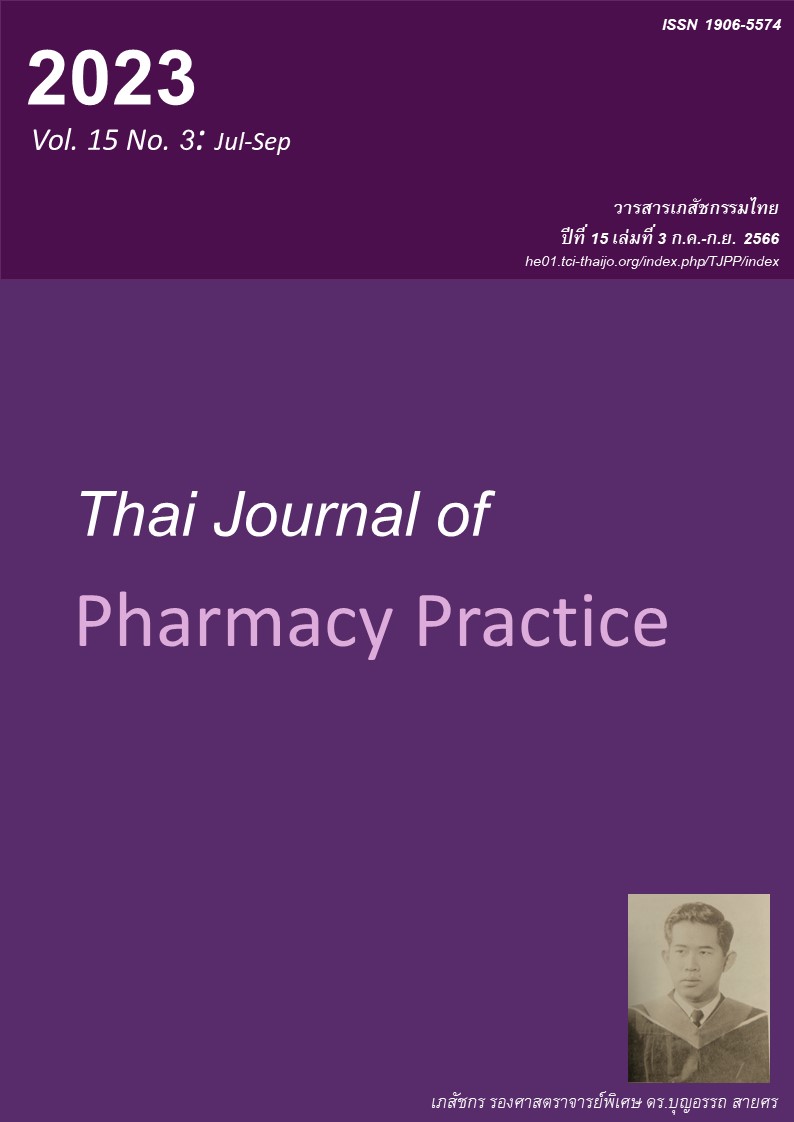ความเหมาะสมของการเก็บยาต้านวัณโรคที่บ้านของผู้ป่วยในอำเภอรามัน จังหวัดยะลา
Main Article Content
บทคัดย่อ
วัตถุประสงค์: เพื่อศึกษาความเหมาะสมของการเก็บรักษายาต้านวัณโรคที่บ้านของผู้ป่วยในประเด็นสถานที่ที่ผู้ป่วยเก็บยา อุณหภูมิ และความชื้นในสถานที่ที่ผู้ป่วยเก็บยา รวมทั้งประเมินความรู้ของผู้ป่วยในเรื่องการเก็บรักษายาอย่างเหมาะสม วิธีการ: ตัวอย่างในการวิจัย คือ ผู้ป่วยวัณโรคซึ่งขึ้นทะเบียนการรักษา ณ คลินิกวัณโรค โรงพยาบาลรามัน จังหวัดยะลา จำนวน 60 คน ผู้วิจัยเยี่ยมบ้านผู้ป่วยเพื่อสังเกตและสัมภาษณ์ผู้ป่วยหรือญาติในประเด็นสภาพแวดล้อมของบ้านพักผู้ป่วย สถานที่ที่ผู้ป่วยเก็บยาต้านวัณโรค และความรู้ในการเก็บรักษายา ตลอดจนตรวจสอบลักษณะทางกายภาพของยาที่บ่งบอกถึงการสลายตัว วัดอุณหภูมิและความชื้นในบ้านและสถานที่ที่ผู้ป่วยเก็บยา ผลการวิจัย: ผู้ป่วยวัณโรคร้อยละ 96.67 อาศัยในบ้านเดี่ยวที่ไม่มีผนังติดกับบ้านหลังอื่น ๆ ลักษณะบ้านเป็นบ้านก่ออิฐชั้นเดียว (ร้อยละ 36.40) บ้านของผู้ป่วยร้อยละ 65.00 ไม่มีหน้าต่างให้อากาศถ่ายเทได้สะดวก การประเมินความรู้เกี่ยวกับการเก็บรักษายาพบว่าได้คะแนนเฉลี่ย 3.88±1.86 จากคะแนนเต็ม 7 คะแนน แสดงว่า ผู้ป่วยมีความรู้ในระดับปานกลาง คำถามที่ตัวอย่างตอบถูกน้อยที่สุด คือ “ควรแกะเม็ดยาที่บรรจุในแผงออกมาเก็บใส่ไว้ในตลับยา” และ “ยาเม็ดที่สั่งใช้ให้รับประทานครึ่งเม็ด ควรแบ่งยาไว้ล่วงหน้าและใส่ในตลับยา” (ตอบถูกเพียงร้อยละ 26.67 ในทั้งสองข้อ) ผู้ป่วยส่วนใหญ่จัดเก็บยาในถุงหิ้วเดิมที่ได้รับจากโรงพยาบาล และแขวนไว้ที่บริเวณฝาผนังบ้านหรือฝาผนังห้องกลางบ้าน (ร้อยละ 35.00) เป็นบริเวณที่มีการส่องถึงของแสงแดด (ร้อยละ 46.67) มีการแยกเก็บยาจากยาอื่น (ร้อยละ 86.67) อุณหภูมิภายในบ้านและภายในภาชนะที่เก็บยามีค่าสูงกว่า 30 ๐ C พบในตัวอย่างร้อยละ 81.67 และ 90.00 ตามลำดับ ความชื้นสัมพัทธ์ภายในบ้านและภาชนะที่เก็บร้อยละ 75.00 และ 75.00 ตามลำดับ มีค่าสูงมากกว่าร้อยละ 60 การศึกษาพบการเปลี่ยนแปลงทางกายภาพของสีเม็ดยา isoniazid ในตัวอย่าง 1 ราย (ร้อยละ1.67) ผู้ป่วยในการศึกษานี้เพียง 1 ราย (ร้อยละ 1.67) เท่านั้นที่เก็บยาได้เหมาะสมตามคำแนะนำของผู้ผลิต คือ อุณหภูมิไม่เกิน 30°C ความชื้นสัมพัทธ์ไม่เกิน ร้อยละ 60 และเก็บพ้นแสง ยกเว้นยารวมเม็ด 4 ชนิดหรือ rifafour e-275 ที่ต้องเก็บที่อุณหภูมิไม่เกิน 25°C สรุป: ผู้ป่วยจำนวนมากเก็บรักษายาต้านวัณโรคที่บ้านอย่างไม่เหมาะสม ผู้ป่วยมีความรู้ในเรื่องการเก็บรักษายาอย่างเหมาะสมประมาณครึ่งหนึ่งของคะแนนเต็ม บุคลากรทางการแพทย์โดยเฉพาะเภสัชกรควรตระหนักถึงความสำคัญในการให้ข้อมูลการเก็บรักษายาแก่ผู้ป่วยหรือญาติผู้ป่วย และที่สำคัญ คือ การติดตามเยี่ยมบ้านผู้ป่วยของทีมสหวิชาชีพควรต้องดูแลการเก็บรักษายาที่บ้านของผู้ป่วยร่วมด้วยเสมอ
Article Details

อนุญาตภายใต้เงื่อนไข Creative Commons Attribution-NonCommercial-NoDerivatives 4.0 International License.
ผลการวิจัยและความคิดเห็นที่ปรากฏในบทความถือเป็นความคิดเห็นและอยู่ในความรับผิดชอบของผู้นิพนธ์ มิใช่ความเห็นหรือความรับผิดชอบของกองบรรณาธิการ หรือคณะเภสัชศาสตร์ มหาวิทยาลัยสงขลานครินทร์ ทั้งนี้ไม่รวมความผิดพลาดอันเกิดจากการพิมพ์ บทความที่ได้รับการเผยแพร่โดยวารสารเภสัชกรรมไทยถือเป็นสิทธิ์ของวารสารฯ
เอกสารอ้างอิง
World Health Organization. Global tuberculosis report 2021. Geneva, Switzerland: WHO; 2021.
Bureau of Tuberculosis. National tuberculosis control programme guideline, Thailand 2021. Bangkok: Aksorn Graphic and Design; 2021.
Ministry of Public Health, Key performance index No 25: Success rate for the treatment of new patients with pulmonary tuberculosis [online]. 2022 [cited Jul 16, 2022]. Available from: healthkpi.moph.go.th /kpi2/kpi/index/?id=1592&kpi_year=2564
World Health Organization. Guidelines for the pro- grammatic management of drug-resistant tubercu- losis. Geneva, Switzerland: WHO; 2008.
Office of Global Fund Management. Details of the contract for packaging and distribution of standard regimen of anti-tuberculosis medications of The Global Fund [online]. 2014 [cited Jul 14, 2015]. Available from: www.thaiprddc.org/download/article /article_20140107162525.pdf.
Rookkapan K, Chongsuvivatwong V, Kasiwong S, Pariyawatee S, Kasetcharoen Y, Pungrassami P. Deteriorated tuberculosis drugs and management system problems in lower southern Thailand. Int J Tuberc Lung Dis. 2005; 9: 654-60.
Singh S, Mohan B. A pilot stability study on four-drug fixed-dose combination anti-tuberculosis products. Int J Tuberc Lung Dis. 2003; 7: 298-303.
Basu S, Garg S, Sharma N, Singh MM. Improving the assessment of medication adherence: Challenges and considerations with a focus on low-resource settings. Ci Ji Yi Xue Za Zhi 2019; 31: 73-80. doi: 10.4103/tcmj.tcmj_177_18.
Jafarzadeh A, Mahboub-Ahari A, Najafi M, Yousefi M, Dalal K. Medicine storage, wastage, and associated determinants among urban households: a systematic review and meta-analysis of household surveys. BMC Public Health 2021; 21: 1127. doi: 10.1186/s12889-021-11100-4.
Huang Y, Wang L, Zhong C, Huang S. Factors influencing the attention to home storage of medicines in China. BMC Public Health 2019; 19: 833. doi: 10.1186/s12889-019-7167-5.
Jassim AM. In-home drug storage and self-medica- tion with antimicrobial drugs in Basrah, Iraq. Oman Med J 2010; 25: 79-87. doi: 10.5001/omj.2010.25.
Leelahawong Y. Problems on inappropriate drug storages identified from medications brought to hospitals by patients with chronic diseases during their hospitalization. Thai Journal of Pharmacy Practice 2021; 13: 803-11.
Cochran WG. Sampling techniques. 3rd Ed. New York: John Wiley & Sons; 1977.
Wongruttanachai A, Chanprateep S, Kumpiroand K, Klinsrisuk B. Provision of advice on drug storage to pharmacy customers in Bangkok. Naresuan University Journal 2008; 16: 211-9.
Socarras S, Magari RT. Modeling the effects of storage temperature excursions on shelf life. J Pharm Biomed Anal 2009; 49: 221-6.
Hewson C, Shen CC, Strachan C, Norris P. Personal medicines storage in New Zealand. J Prim Health Care 2013; 5: 146–50.
International Programme on Chemical Safety (IPCS). Ethambutol [online]. 1990 [cited Aug 24, 2011]. Available from: www.inchem.org/documents /pims/pharm/ethambut.htm
Saengmanee V. Temperature [online]. 2013 [cited Sept 24, 2022]. Available from: www.geog.pn.psu. ac.th/CAIClimate/4Temperature49.pdf


